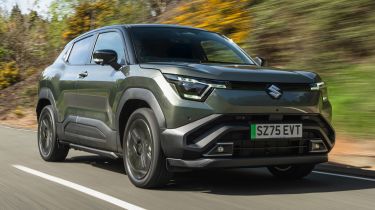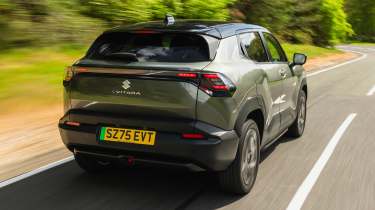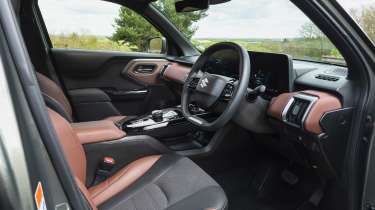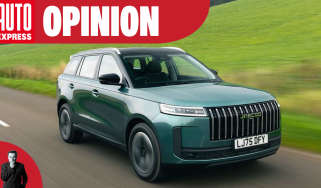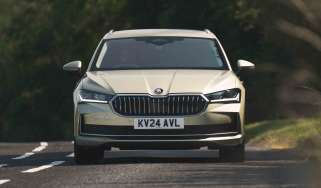New Suzuki e Vitara 2025 review: plenty of appeal but let down by range and charging
The new Suzuki e Vitara struggles to stand out in a sea of impressive electric SUVs

Verdict
With genuine off-road ability in dual-motor trim, the Suzuki e Vitara offers something different in the increasingly congested electric crossover market. Unfortunately for Suzuki, it’s a segment with very strong competition and the e Vitara’s range and charging performance lets it down slightly, as does its cheap-feeling cabin. It’s a good thing, then, that Suzuki has made the e Vitara remain an attractive option thanks to that massive grant.
We first saw the Suzuki e Vitara as the EVX concept back in 2023 and drove it as a prototype earlier this year – but now it’s time to try it out in production guise.
That little ‘e’ designation for the Vitara is pretty significant for Suzuki, as it signifies the car is fully electric, making this the brand’s first pure electric car. Being a similar size to the existing Vitara Hybrid (which remains on sale alongside the new electric model), the e Vitara has plenty of rivals, ranging from the Renault 4, Kia EV3, Ford Puma Gen-E and our Car of the Year – the Skoda Elroq.
It also has Toyota’s next electric vehicle, the Urban Cruiser to contend with, which is actually the sister model to the e Vitara. It’s the latest in a series of recent joint ventures between the brands, which has resulted in the Swace and the Across – but unlike those two cars, Suzuki took the lead role in developing the e Vitara. As a result, it beats the Urban Cruiser to the UK market by around six months.
Used - available now

2020 Suzuki
Vitara
21,949 milesAutomaticPetrol1.4L
Cash £15,000
2020 Suzuki
Vitara
30,172 milesAutomaticPetrol1.4L
Cash £14,400
2020 Suzuki
Vitara
21,966 milesAutomaticPetrol1.4L
Cash £14,607
2019 Suzuki
Vitara
26,663 milesAutomaticPetrol1.0L
Cash £12,520Suzuki hasn’t just used a shrunken version of the Toyota Toyota bZ4X’s e-TNGA platform for the e Vitara, either. Instead it gets the all-new ‘Heartect-e’ architecture that Suzuki has jointly developed with Toyota and Daihatsu. Made specifically for electric cars, Heartect-e caters to single as well as dual-motor configurations, ensuring Suzuki’s ‘AllGRIP’ four-wheel drive capacity lives on into the electric era.
Two battery capacities are offered with the e Vitara, 49kWh and a 61kWh, Both are compact ‘blade’ batteries and are sourced from BYD. The smaller battery comes with a 142bhp electric motor and a 9.6-second 0-62mph time, while the 61kWh unit comes with either a single 172bhp electric motor for an 8.7-second 0-62mph time or a dual-motor four-wheel drive set-up with 181bhp, dropping the sprint to 7.4 seconds.
With batteries coming from BYD and the e Vitara built in India, Suzuki hasn’t managed to secure the government-backed Electric Car Grant, but in August it introduced its own ‘Suzuki Granted’ discount of £3,750, which runs until the end of 2025. With that in place, the e Vitara starts at £26,249 for the smaller battery model, £29,249 for the single-motor 61kWh and £31,249 for the dual-motor. All three come in Motion trim with a better-equipped Ultra adding £2,800 to the 61kWh cars.
While the 49kWh gets that headline price tag, it also has a rather meagre 214-mile WLTP range. The e Vitaras we tested were the 61kWh models in single and dual-motor guise. We couldn’t quite reach the claimed 264-mile range, with a mix of driving seeing us reach an efficiency of 3.5 miles per kW - which would’ve given us 213 miles. The dual-motor is less efficient with its claimed 246-mile range, though it’s worth pointing out that all models come with a heat pump as standard, so you shouldn’t see a big drop in winter months.
The e Vitara’s charging isn’t exactly class-leading either. While it has an impressive 150kW maximum charging speed (Stellantis’ Jeep Avenger and Vauxhall Mokka Electric top out at 100kW), it’ll take 45 minutes to recharge 10-80 per cent, whether you’re in the small or large battery model. Suzuki does say it has the ability to improve the e Vitara charging speeds in future via over-the-air updates however.
Pulling away, the first thing you notice is there’s a load of familiar Toyota switchgear. Suzuki took the lead with development of the e Vitara’s chassis, but despite a need for off-road ability (we’ll come to this later), the on-road manners are pretty good.
The overall ride is on the soft side, but despite our car’s 1,799kg kerbweight (the 49kWh car is 100kg less and the dual-motor 100kg more), the e Vitara feels surprisingly light and bouncy on country roads with a noticeable amount of lean in tighter corners. This means that big road imperfections like potholes, speedbumps and drain covers are dealt with easily, but the e Vitara’s ride often feels quite busy – even on the motorway. That seemed to be the case on the Motion spec’s 18-inch wheels and the Ultra’s 19-inch ones. We also experienced a fair bit of wind noise at higher speeds, though road noise was well suppresed.
We like the e Vitara’s driver inputs however. Suzuki has done a good job with the steering weight and brake feel, though if you switch between ‘Eco’, ‘Sport’ and ‘Normal’ modes the only change you’ll notice is a slightly more responsive throttle. You can change the brake regeneration between three levels, however you have to delve into the touchscreen menus to do this, and it’s a bit of a faff.
You sit quite high up, too. We had the driver’s seat all the way down and could easily see the front of the bonnet, meaning all-round visibility is great. Despite a fairly long wheelbase of 2,700mm (200mm longer than the Vitara Hybrid) the e Vitara’s turning circle is no different at 10.4 metres, meaning it’s a doddle to guide around tight urban areas. What doesn’t help, though, is the rear-view camera. It’s a standard feature, but the picture quality is horrendous.
Unlike many of its rivals, the e Vitara comes with four-wheel drive courtesy of Suzuki’s AllGrip-e technology. While power doesn’t rise much with the addition of another motor, torque rises from 193Nm to 307Nm - making a notable improvement to straight-line acceleration at higher speeds. Where AllGrip-e really shines is off-road – we managed to take the e Vitara through a pretty challenging course with no issue, all on standard road tyres. In the AllGrip-e’s bespoke ‘Trail’ mode, the Suzuki monitors wheel slip and can distribute power between both axles. We reckon with a set of knobbly off-road tyres the e Vitara might show up some much more expensive 4x4s on the rough stuff.
The exterior of e Vitara sticks close to the eVX’s chunky design, though inside is a little more bland. We’d suggest going for the black and tan interior (even though it’s only an option paired with the basic silver or the green metallic), just to bring some colour inside - the same can be said of the fixed sunroof, which is standard on the Ultra spec.
The two screens on the dash operate a Toyota-based infotainment system while it’s simple to understand, it looks a little dated compared to rivals. The 10.25-inch driver’s display relays all the key information clearly, with scope to customise the outer sections with radio, map or EV data. The 10.1-inch central screen is also pretty straightforward, although we experienced a little bit of lag between the menus. Proper physical controls for climate and trip computer information on the steering wheel in the e Vitara are refreshing features, though.
As for build quality, the e Vitara seemed sturdy enough - though the cabin didn’t feel particularly premium and we noticed some large panel gaps. We counted no less than seven different materials on the doors, plus a large swatch of hard scratchy plastic on the top of the dash. The centre console, mainly made of piano-black plastic, also seems ripe for scratches after hard use.
Space is generally good front and rear. The door bins can hold large water bottles and if you fold the middle rear seat down you’ll get an extra two cup-holders. The two outer rear seats have a set of Isofix child seat mounting points, too.
The rear seats slide on a 40:60 split and fold in a 40:20:40 split so there’s a decent amount of adjustability back there. If you slide them all the way to the front, you lose a lot of rear legroom, but boot space goes from 244 litres to 310 litres. This doesn’t sound great on paper but in reality it’s a useful, squared-shaped space that does the job. Ultra-spec cars have a slightly smaller boot due to the encroachment of the uprated sound system.
The industry standard EV battery warranty seems to be eight years, but Suzuki offers a service-activated warranty for up to 10 years or 100,000 miles, which includes the battery.
| Model: | Suzuki e Vitara Motion 61kWh |
| Price: | £29,249 |
| Powertrain: | 61kWh battery, 1x e-motor |
| Power/torque: | 174bhp/193Nm |
| Transmission: | Single-speed auto, front-wheel drive |
| 0-62mph: | 8.7 seconds |
| Top speed: | 93mph |
| Range: | 264 miles |
| Max charging: | 150kW (10-80% in 45 minutes) |
| Size (L/W/H): | 4,275mm/1,800/1,640mm |

